Tomato Em Champion: characteristics and description of the variety, reviews from those who planted tomatoes and photos
Tomato Em Champion, a gift from specialists from Siberia, is a universal crop: it is grown both in garden beds and on the balcony. The compact and high-yielding plant is so unpretentious in care that a beginner who takes up seedlings for the first time will certainly receive an excellent harvest.
This tomato variety is immune to many diseases and is well adapted to the vagaries of the weather, which allows it to fully grow and develop in any region of our country.
Characteristics and description of the variety
Em Champion was bred by Siberian breeders and entered into the State Register of Breeding Achievements in 1982.
Bush determinant, height - no more than 70 cm, medium foliage, large leaves. Due to its low height, this variety can be grown in an apartment on the balcony. The first inflorescence is laid above the 5-7th leaf, the subsequent ones - every two leaves. 4-5 fruiting clusters are formed on one seedling.
The species is mid-season, 100-110 days pass from planting to full ripening.
It is highly resistant to the main diseases of the nightshade family, in particular, practically immune to fungal diseases.
The productivity is high, up to 7 kg of fruits are harvested from one plant, provided that four bushes are planted per 1 square meter. m.
The tomato is recommended for growing in open ground. In cold regions it is bred in protected structures.
Despite its small growth, the plant requires obligatory garter, otherwise the stem will not withstand the weight of ripe fruits. When grown in open beds, it does not require pinching.
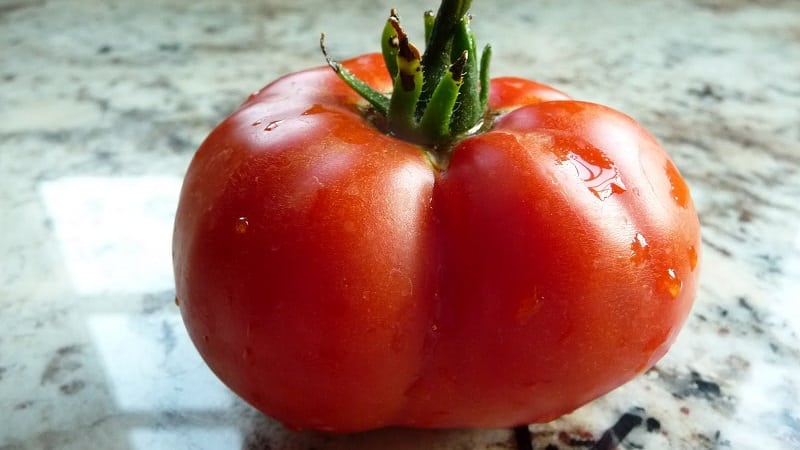
The fruits are large, the average weight of one is 350-450 g. They have a crimson color, a round and slightly flattened shape (see photo). There are 4-5 seed chambers. The taste is excellent, harmoniously combining sugariness with sourness.
Vegetables are consumed fresh and used for preparing winter preparations (barrel pickles, marinades and canning).
Ripe tomatoes are not subject to long-term storage and do not retain their presentation during transportation. For this reason, the crop is not grown commercially.
Advantages and disadvantages
The Em Champion variety has many positive qualities, thanks to which it is in great demand among gardeners:
- ease of care;
- high resistance to diseases;
- high fruiting rate;
- good adaptation to weather conditions in open ground;
- resistance to sudden temperature changes;
- does not require mandatory stepsoning;
- possibility of breeding on the balcony;
- good taste of fruits;
- large size vegetables;
- the ability to independently select seeds for the next planting.
Negative qualities include:
- short shelf life of ripe vegetables;
- need for garter;
- impossibility of growing the crop on an industrial scale.
Features of planting and care
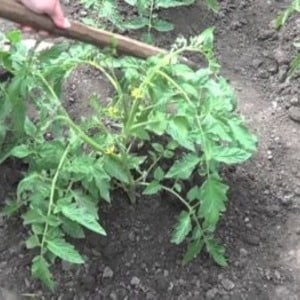 Sowing begins 60 days before planting seedlings in open ground. The final dates are determined in accordance with the climatic characteristics of the region.
Sowing begins 60 days before planting seedlings in open ground. The final dates are determined in accordance with the climatic characteristics of the region.
Both common wooden boxes and individual plastic glasses or peat pots serve as planting containers. Small holes are made at the bottom of the containers so that excess moisture does not remain trapped during watering.
The containers are filled with nutritious soil, which is prepared from a mixture of garden soil with peat and humus in equal parts. The prepared soil is scalded with boiling water or watered with a solution manganese dark color - thus destroying pathogenic flora.
Before sowing seeds disinfected in a weak solution of potassium permanganate and treated with a growth stimulator to improve germination.
The seed is laid to a depth of 1.5 cm and compacted well on top.
Reference. When planted shallowly, most seeds germinate along with the seed coat, which noticeably slows down their further growth.
After planting, the containers are covered with film and left indoors at a temperature of at least 23°C. At the first shoots, the planting containers are moved to a more illuminated place, but not in direct sunlight.
Water lightly without over-moistening the soil. After each watering, loosen the soil with a fork or wooden stick.
When two true leaves appear, the seedlings dive, planting them in separate containers. The day before picking, the sprouts are watered for easier removal from containers without damaging the root system.
Two weeks before transplanting into open ground, young bushes begin to harden. To do this, they are taken out into the open air for 2-3 hours. The night temperature in the room is reduced to 13°C. Gradually, the time spent on the street is increased to 18 hours.
Growing in open ground
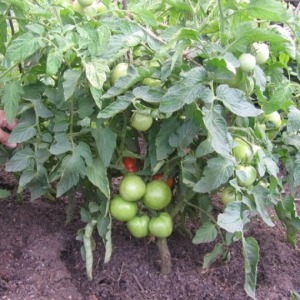 After 60 days, the seedlings are ready for transplanting. The best option for seedlings is loamy soil, therefore, if there is a lot of clay in the soil, you need to add river sand or peat in the amount of 3-4 buckets per 1 square meter to make it lighter. m.Compost is added as fertilizer (two buckets per 1 sq. m).
After 60 days, the seedlings are ready for transplanting. The best option for seedlings is loamy soil, therefore, if there is a lot of clay in the soil, you need to add river sand or peat in the amount of 3-4 buckets per 1 square meter to make it lighter. m.Compost is added as fertilizer (two buckets per 1 sq. m).
Planting pattern: 40 cm – distance between seedlings, 50 cm – between rows. Superphosphate and ash are added to each well.
It is best to replant in cloudy weather or in the evening. After transplanting, the beds are moderately watered with warm, settled water at the root of the plant.
Regular watering is established as young bushes take root. Water no more than twice a week, with the exception of hot days, when the number of waterings is increased to 3-4 times.
After watering, the beds are loosened and mulch. These procedures not only have a beneficial effect on the development of seedlings, but also serve as preventive measures in the fight against pests.
The plant is fed three times a season with complex fertilizers or organic matter. A product made from nettles and dandelions, which is infused in the sun for 10 days, is well suited as an organic product. Before watering, the infusion is diluted in a ratio of 1:10.
Reference. Organic fertilizers must be diluted in a large ratio, otherwise the root system may burn.
Despite its small growth, the crop requires obligatory garter. To do this, wooden stakes or a metal support are installed next to each bush. As they grow, they are fixed to supports and branches, since they cannot support the weight of ripe fruits.
The Em Champion tomato does not require mandatory pinching. Stepchildren are removed only initially, until the first fruiting cluster is formed.
Harvest and use of vegetables
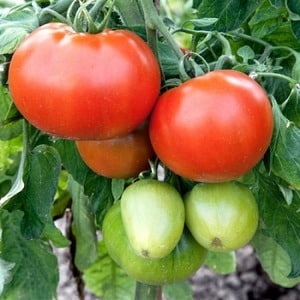 This tomato has established itself as a high-yielding crop. One small plant produces up to five fruiting clusters, each of which develops up to six weighty fruits.Consequently, up to 7 kg of vegetables are obtained from one plant, and from 1 sq. m – up to 28 kg of excellent tomatoes.
This tomato has established itself as a high-yielding crop. One small plant produces up to five fruiting clusters, each of which develops up to six weighty fruits.Consequently, up to 7 kg of vegetables are obtained from one plant, and from 1 sq. m – up to 28 kg of excellent tomatoes.
The only negative is the short-term storage of ripe vegetables. When collected en masse, they are immediately canned or processed. It is for this reason that farmers do not like to grow the Em Champion variety.
Thanks to the amazing taste of tomatoes, which harmoniously combines sweetness and sourness, vegetables make excellent juices and pastes. This is an indispensable basis for hot and vegetable dishes and various sauces.
Tomatoes do not lose their taste pickling And marinades, go well together and complement any other variety in winter preparations.
Diseases and pests: control methods and prevention
Despite the high resistance of the crop to diseases of the nightshade family, tomato is still susceptible to bacterial black spot and blossom end rot. These are fungal diseases, the pathogens of which successfully reproduce at high humidity and air temperature.
Prevention against them includes monitoring moisture in the beds, timely loosening the soil and removing weeds with roots. For treatment, use a calcium nitrate solution by spraying diseased plants. The drug “Fitolavin” helps against bacterial spotting.
To protect the crop from attacks by insect pests (whiteflies, mole crickets, slugs, cutworms), plants are sprayed with infusions of fragrant herbs once a week. It is also good to plant sharp-smelling herbs next to tomatoes.
Crushed cloves of garlic and fish heads buried in the beds help against pests. The Colorado potato beetle and slugs are collected by hand, and the soap solution used to treat the stems saves from aphids.
Among the industrial insecticides, the preparations “Zubr” and “Lepidotsid” are used.But do not forget that chemical treatment is possible only until the first ovaries.
Reference. Tomatoes grown on balconies, as a rule, do not get sick and are not attacked by parasitic insects.
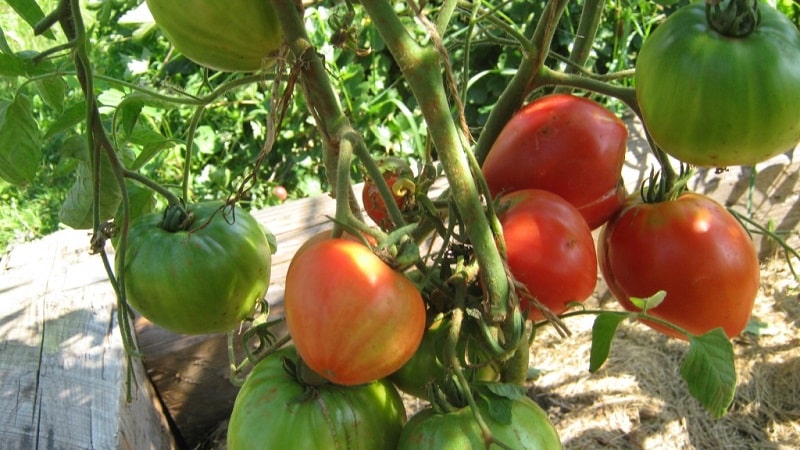
Reviews
Reviews from gardeners confirm the unpretentiousness of this variety of tomatoes in care. Minimal expenditure of effort and time leads to a rich harvest.
Inna, Tambov region: “Truly a champion! From one seedling I got a whole bucket of tomatoes. Very large vegetables, which is surprising for such bushes, and the taste is wonderful. I will definitely plant more!”
Valentin, Voronezh region: “My favorite tomato, I plant it every year. I really like it: the bushes are not tall, the tomatoes are fleshy and large, and most importantly - healthy throughout the season. I just water and feed them. I’m always happy with the result.”
Conclusion
A clear champion in yield among tomato crops, the tomato from Siberian breeders appeared on the beds of our country more than 35 years ago. Impressive characteristics - high disease resistance, simple agricultural technology, adaptation to any weather conditions, the ability to grow on a balcony - allow it to maintain a leading position among other varieties.
Em Champion can confidently be called a long-liver, having survived a difficult era and is ready to win new fans.